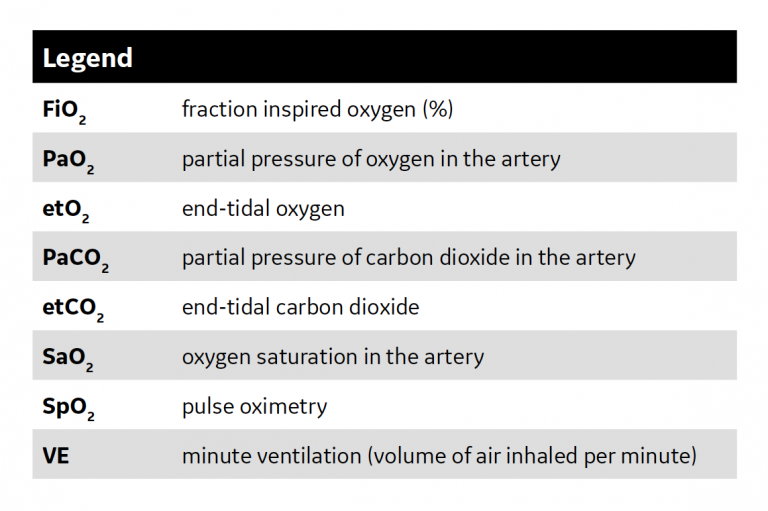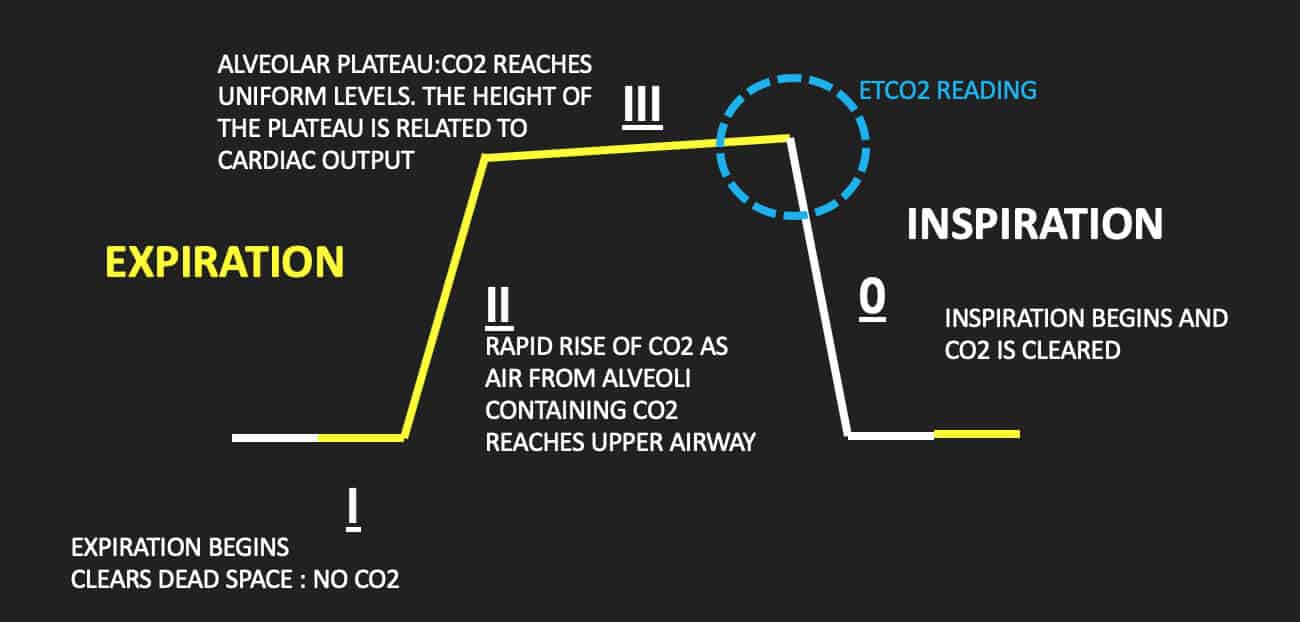end tidal co2 range high
Where the respiratory rate is very low and the tidal volumes are very large the end-tidal CO 2 can be higher than the mean arterial CO 2. What is considered high tidal volume.

Waveform Capnography In The Intubated Patient Emcrit Project
A prospective clinical trial was conducted at a level I trauma center to assess the efficacy of end-tidal carbon dioxide CO2 detection in four groups of patients requiring emergency intubation because of cardiac arrest major trauma respiratory failure or the need for airway protection.

. The height of the capnography waveform accompanies this number on the monitor as well as the respiratory rate. A low end-tidal CO2 may indicate poor perfusion hypovolemia or sepsis. 35-45 mm HG.
2 Strategies for Treatment S The waveform morphology during CPR can help us decide what our next intervention should be. An increase of EtCO2 to normal values 35-45 mm Hg or an increase by 10 mm Hg is about 97 specific. The amount of CO2 at the end of exhalation or end-tidal CO2 ETCO2 is normally 35-45 mm HG.
There was no significant change in EtCO2 after treatment. The diagnosis of sleep apnea syndrome SAS requires expensive and complex instrumentation. An accurate early predictor of the outcome of resuscitation is needed.
The median initial PEFR was 200 interquartile range IQR. Capnography can be used to measure end-tidal CO 2. For example a patient compressed to 20 ATA may have an actual end-tidal carbon dioxide level of 36 torr.
The median EtCO2 at T0 and T60 was 35 IQR. Literature search was performed using Medline and EMBASE. Examples of some common capnograms are.
Thirty-nine patients referred to our sleep laboratory because of suspected SAS and ten normal subjects were studied. Capnography waveforms etCO2 and breathing patterns. I suppose that the model eg.
Two cases of malignant hyperthermia are described where the earliest sign was a rise in the end-tidal CO2 concentration. Ideally this value should measure 18 362 with a monitor. Since problems with lungs are not common and gas exchange between alveoli and the blood is swift and effective.
In normal healthy lungs the match of arterial carbon dioxide and exhaled CO 2 is closely correlated. Because the patient is compressed and the analyzer is calibrated at atmospheric pressure the measured end-tidal carbon dioxide values must be corrected for interpretation. High VT and low resp rates.
30-38 and 34 IQR. This is result of a slower expiration. There was no significant change in the Q angle and the T time after treatment.
Animals that are breathing spontaneously should have an end-tidal carbon dioxide concentration in the range of 46. Although the normal range for CO2 should be between 35-45mmHg CO2 monitoring gives healthcare providers a lot more insight into what is going on with a patients condition. End tidal CO 2 EtCO 2 monitoring is the fastest indicator of ventilatory compromise.
Most anesthetics are respiratory depressants and end-tidal CO2 allows early detection of respiratory impairment so appropriate intervention can occur before the problem becomes life threatening. The number is called capnometry which is the partial pressure of CO 2 detected at the end of exhalation ranging between 35 - 45 mm Hg or 40 57 kPa. One caveat is that sodium bicarbonate may transiently raise the EtCO2 but this does not reflect ROSC.
The waveform is called capnograph and shows how much CO 2 is present at each phase of the respiratory cycle. Variants of normal ETCO2 tracings from normal anesthetized animals. The purpose of this systematic review is to evaluate the prognostic value of ETCO2 during cardiac arrest and to explore whether ETCO2 values could be utilised as a tool to predict the outcome of resuscitation.
1-3 Clinicians may however observe a widened or increased gradient caused by physiologic dead. Traditionally high tidal volumes of 10 to 15 mL per kilogram of predicted body weight have been used to improve oxygenation and achieve normal or even low arterial carbon dioxide and pH levels. Forty-six of 96 48 95 confidence interval CI 38 58 patients had abnormal ETCO 2 values including 37 39 95 CI 29 49 with low ETCO 2 levels and nine 9 95 CI 4 17 with high ETCO 2 levels.
With a normal match of alveolar ventilation and perfusion this gradient is roughly 2 to 5 mmHg where the arterial carbon dioxide is greater than the exhaled carbon dioxide. The purpose of the present study was to determine the value of end-tidal CO2 EtCO2 in screening for sleep apneas. According to the book by Hockenberry and Wilson 2015 p 1140 normal values of ETCO2 are 30-43 mmHg which is slightly lower than arterial PaCO2 35-45mmHg.
The median ETCO 2 value was 32 mmHg IQR 27 38 mmHg range 18-80 mmHg. Common narrow plateaus seen during. In severe cases of respiratory distress increased effort to breathe does not effectively eliminate CO2.
In conditions of normal breathing 6 Lmin 12 breathsmin 500 ml for tidal volume etCO 2 is very close to alveolar CO2. The amount of CO2 at the end of exhalation or end-tidal CO2 ETCO2 is normally 35-45 mm HG. A semiquantitative colorimetric FEF end-tidal CO2.
Deeper slower alveoli are able to share their gas with the capnometer whereas previously that gas would have remained in the airway. Most studies comparing conventional with protective ventilation have used tidal volumes of 12 mLkg.

End Tidal Oxygen Measurement White Paper Clinical View

Waveform Capnography In The Intubated Patient Emcrit Project

Basic Capnography Interpretation Nuem Blog
Riding The Wave Of Capnography Understanding Etco2 Vetbloom Blog
End Tidal Co2 The Drummer Of The Vital Sign Band Pem4

Exhaled Carbon Monoxide End Tidal Co2 And Peripheral Oxygen Saturation Download Table

5 Medical Conditions Where Capnography Can Affect Bls Care

End Tidal Capnography Can Be Useful For Detecting Diabetic Ketoacidosis Monitoring Copd Acep Now

Exhaled Carbon Monoxide End Tidal Co2 And Peripheral Oxygen Saturation Download Table
Emdocs Net Emergency Medicine Educationcapnography In The Ed Emdocs Net Emergency Medicine Education

Etco2 Valuable Vital Sign To Assess Perfusion The Airway Jedi
End Tidal Co2 Monitoring In The Pre Hospital Environment More Than Just Endotracheal Tube Placement Confirmation Journal Of Paramedic Practice

Waveform Capnography In The Intubated Patient Emcrit Project

How To Read And Interpret Capnography Waveforms Infinium Medical

Capnography Provides Bigger Physiological Picture To Maximize Patient Care Jems Ems Emergency Medical Services Training Paramedic Emt News

The Impact Of Ventilation Rate On End Tidal Carbon Dioxide Level During Manual Cardiopulmonary Resuscitation Resuscitation

